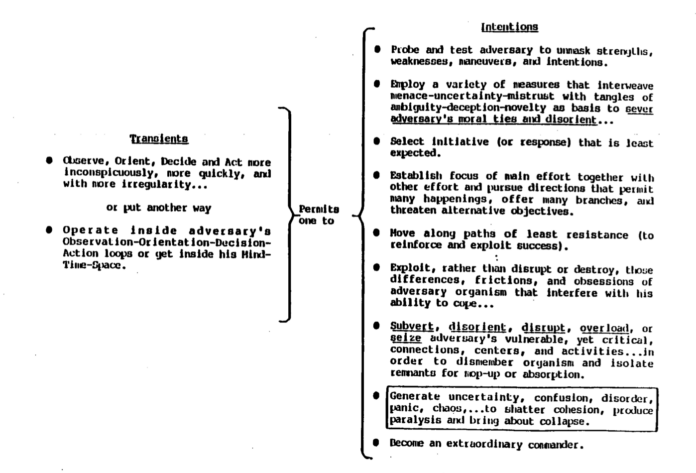Article Excerpt:
John Boyd studied. He studied fighter pilot tactics, studied aeronautical engineering, studied bureaucrats and how to avoid their traps, studied evolution and biology, and studied history.
And Boyd synthesized in a way that only a real practitioner of war could to produce a briefing called Patterns of Conflict that is still having a big impact on the world today.
- Evolution since the very beginning of life has been about competition. All animals, but especially humans, are coded to survive. Free societies should reflect that and understand we must survive on our own terms.
- War itself is a human activity that can be studied and patterns of conflict can be deduced. Free societies should apply these lessons to ensure survival.
- In dynamic situations, decision-makers should act fast. The Observe-Orient-Decide-Act model takes this into account and emphasizes that operations should proceed at a tempo that is inside the adversary’s OODA Loop.
- Operating inside the adversary’s OODA Loop will improve chances of success because of the better faster decisions. Operating inside the adversaries OODA Loop also generates confusion and disorder among adversaries since they will be unable to gain situational awareness to fuel their decisions.
Analysis:
John Boyd’s briefing called “Patterns of Conflict” emphasizes the fact that the act of war and combat is within our human nature to compete. Throughout human history, we have had to compete for resources to survive. War and combat can be observed for the entirety of humanity, and we are able to identify patterns within this behavior. From looking into our past, “patterns of conflict can be deduced,” ones of which we can observe, study, and learn from to achieve success on the battlefield.
Some observable patterns of victorious warfare include; rapid decision making and swift action, causing confusion and disorder within adversary groups, understanding the adversaries and their mindsets, and more. While it is important that we physically prepare our troops with adequate technology and physical means for combat, we must also prepare our troops with a sound mental model and critical thinking skills that promote rapid action and decision making. Not only do we need to master the science of war, but the art of war as well.




